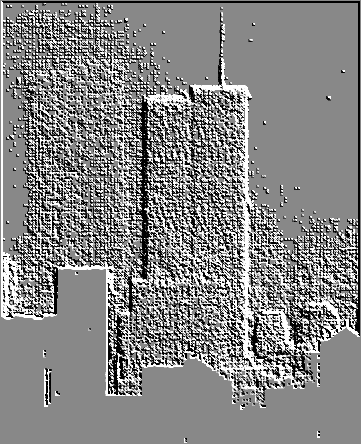The World
Trade Center
Part I

We must not forget how undistinguished the World Trade Center was. "When completed," the authors of the 2000 edition of the AIA Guide to New York City wrote, "these stolid, banal monoliths came to overshadow Lower Manhattan's cluster of filigreed towers, which had previously been the romantic evocation that symbolized the very concept of 'skyline.'"
Ada Louise Huxtable, former architecture critic for The New York Times, described their style as "General Motors Gothic." Her successor, Paul Goldberger, called them "boring, so utterly banal as to be unworthy of the headquarters of a bank in Omaha." Wolf von Eckhardt published an article in Harper's calling the World Trade Center a "fearful instrument of urbicide," and "one of the ugliest buildings in the world." They were monuments to money and power, brutish and ugly, and only in the agony of their final hour did they take on nobility from the valor of those who sought to save the people who worked within their walls.
Until some 40 years ago, the lower west side was an industrial neighborhood. Washington Market, a block-square two-story building at Washington Street between Fulton and Vesey Streets, where 175 merchants dealt in meat, poultry, cheese, butter and garden produce delivered by boat, wagon and truck, dominated the local economy. At Cortlandt St., the huge, faintly seedy Hudson Terminal buildings towered above the terminus of the Hudson Tubes, now the PATH line. Printing plants, warehouses and factories jostled delicatessens, bars, cobblers, hardware stores and barbers. Cortlandt Street had so many electronics retailers that some called it "Radio Row."
David Rockefeller, chairman of Chase Manhattan Bank, had plans for lower Manhattan. After Chase built its 60-story tower on Pine Street in 1960 --- the first new skyscraper in the financial district in a generation --- he sought lower Manhattan's redevelopment through a form of central planning reconciling private interest and public power, rather than the largely spontaneous entrepreneurial development that had historically molded the city's economy.
His urge for civic uplift dovetailed with the real estate interests of his bank and his family. He founded a civic group, the Downtown-Lower Manhattan Association, which in 1958 commissioned the architectural firm of Skidmore, Owings & Merrill to develop an overall plan for lower Manhattan. It included a World Trade Center, which Rockefeller believed would catalyze regional development. He forwarded the plan to the Port of New York Authority, now the Port Authority of New York and New Jersey.
 Austin Tobin, the Port Authority's executive director from the 1940s into the 1970s, presided over the decline of New York's port into what often seems a virtual harbor, a thing of nostalgia trading on the images of its past as at South Street Seaport. Like a minor Robert Moses, Tobin built highway tunnels, airports and the container port at Elizabeth, NJ. Tobin often quoted Daniel Burnham, a brilliant 19th-century Chicago architect and apostle of centralized urban planning: "Make no small plans, for they have no power to stir the blood."
Austin Tobin, the Port Authority's executive director from the 1940s into the 1970s, presided over the decline of New York's port into what often seems a virtual harbor, a thing of nostalgia trading on the images of its past as at South Street Seaport. Like a minor Robert Moses, Tobin built highway tunnels, airports and the container port at Elizabeth, NJ. Tobin often quoted Daniel Burnham, a brilliant 19th-century Chicago architect and apostle of centralized urban planning: "Make no small plans, for they have no power to stir the blood."
Thus, Tobin's pride and the Port Authority's internal culture fueled the ambition to build the world's tallest building. Government power advanced the World Trade Center: the power of the Authority to condemn land and avoid most local environmental laws; of the city to close streets and issue permits; and of the state to transfer its offices into the building to provide it with tenants.
The vision of David Rockefeller and his allies transformed the city's economy from its traditional base as an industrially diverse seaport to one narrowly dependent on finance, insurance and real estate. The World Trade Center, the transformation's monument, was an esthetic debacle: merely the first of the "million-square foot, flat-topped boxes" that, as the AIA Guide notes, "muffle...the constellation of tall, slender, 1920s and 1930s Art Deco office buildings and the flamboyant pinnacles of their earlier, shorter, neo-Classical cousins, the structures that made up the inspired --- if unplanned --- Lower Manhattan skyline that was once the world-renowned symbol of New York City."

 Austin Tobin, the Port Authority's executive director from the 1940s into the 1970s, presided over the decline of New York's port into what often seems a virtual harbor, a thing of nostalgia trading on the images of its past as at South Street Seaport. Like a minor Robert Moses, Tobin built highway tunnels, airports and the container port at Elizabeth, NJ. Tobin often quoted Daniel Burnham, a brilliant 19th-century Chicago architect and apostle of centralized urban planning: "Make no small plans, for they have no power to stir the blood."
Austin Tobin, the Port Authority's executive director from the 1940s into the 1970s, presided over the decline of New York's port into what often seems a virtual harbor, a thing of nostalgia trading on the images of its past as at South Street Seaport. Like a minor Robert Moses, Tobin built highway tunnels, airports and the container port at Elizabeth, NJ. Tobin often quoted Daniel Burnham, a brilliant 19th-century Chicago architect and apostle of centralized urban planning: "Make no small plans, for they have no power to stir the blood."